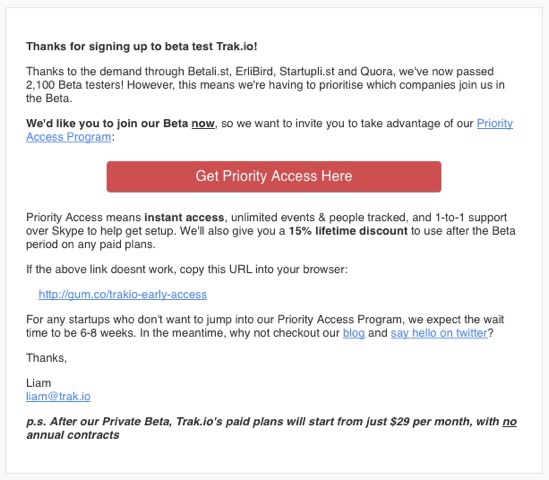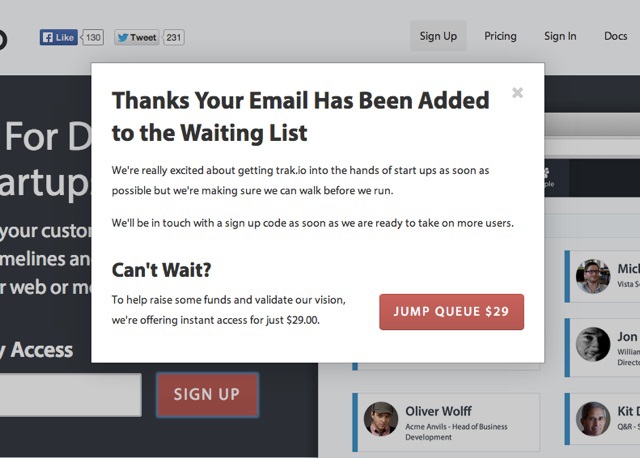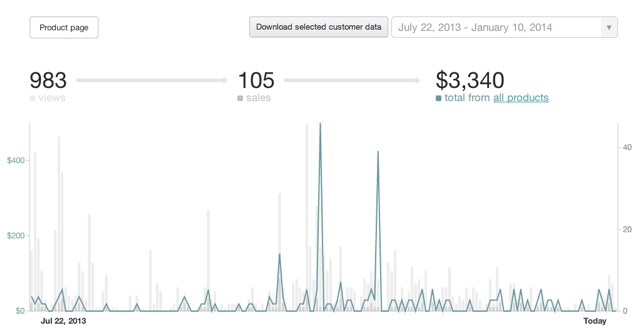Growth Hacking: how to make money on the service before it starts?
 Growth Hacking in projects is usually used at the expansion stage - pumping traffic, when the service already represents something. We recommend reading the article, which proves that Growth Hacking is, above all, a way of thinking, and if you are a true Growth Hacker, then you will use your abilities in any situation. The material is a specific case for increasing the conversion of service into paying customers even at the beta testing stage. How did you manage to crank it?
Growth Hacking in projects is usually used at the expansion stage - pumping traffic, when the service already represents something. We recommend reading the article, which proves that Growth Hacking is, above all, a way of thinking, and if you are a true Growth Hacker, then you will use your abilities in any situation. The material is a specific case for increasing the conversion of service into paying customers even at the beta testing stage. How did you manage to crank it?The article is written in the first person, the author of the introduction and afterwords is Lincoln Murphy, and Liam Gooding tells about the case.
No matter what stage your cloud service is at - preparing to launch, market matching or expanding - Growth Hacking, its methods, tactics and, in particular, the way of thinking can be successfully used to accelerate the growth process at any level.
Of course, the development stage at which the company is located dictates which direction you will develop, which metrics to build up and which methods or tactics to use for this. Let Growth Hacking tactics of not yet launched startups, such as interest formation, popularization, market valuation, may differ from business tactics at the scaling stage when you should focus on increasing the return on the invested dollar. It is still useful to know about the methods that work at all stages, even if they would not seem to be directly related to your current situation.
')
A couple of months ago, I talked about how to use Growth Hacking at the initial stage of startup development with Liam Gooding from Trak.io. When Trak.io was in beta testing, it was possible to register with the service only by invitation, and it took a long time to wait for registration. It was a peculiar way to reduce the costs of maintaining the working infrastructure. And in order to see how much people are willing to pay at all, customers were asked to pay a small amount of money in order to “pass without a turn”. And it worked!
Liam was so kind that he told in detail what exactly was done, what concrete results were obtained, and what was going on in the minds of people who decided to use Growth Hack at such an early stage.
What Liam and his team did on Trak.io , of course, can be used by cloud services at an early stage of development, but if we talk about psychology and style of thinking - namely, the main features of growthacker hide here - they are applicable at any stage . Do not pay attention to the fact that at the time of implementation of this trick, Trak.io was in beta testing, and you, for example, have already passed this stage (why are you upset?) - just get to the bottom of it.
Growth Hacking: how we achieved a conversion rate of 11% on prepay
In just two weeks that have passed since we allowed people to join the private beta version of Trak.io, we overloaded our servers, we needed to reduce the flow of users, somehow limit it. We did not receive any funding at that time, and the hosting bill, which was close to $ 1,000 per month, looked daunting.
Then we thought it was time to try something radical, and started asking for money for using the beta version. Those. even before people could even see, not like trying a product.
All that was was a landing page, where one could get acquainted with our value proposition, and listen to what problems we are trying to save our customers. And that's all. As a lump sum we asked for $ 29. As a result, 11% of users voted "for" their credit card. Now I will tell you more about how we did it, and present all the numbers.
1. People want it immediately!
Since we made people wait for a long time between how they signed up for our service and getting an invite, we lost some of them. “Someone” is not the word. We lost almost 50% of our waiting list. And by the way, it was necessary to wait only a few weeks.
Horror.
It turned out that literally half of the efforts to attract customers was in vain, due to the fact that we asked to wait a couple of weeks. I personally tried to contact the maximum possible number of people for me to chat with them and give an invite in the form of a code. We also had an automatic sequence of emails that fueled subscribers ’interest with useful content and offered them various possibilities of using a promotional code. I wrote to those users who never used promotional codes to gain access, and received mostly these kind of answers: “I don’t remember what it was. I seemed to be subscribing to something else. I lost interest. ”
It was clear that people had to give it at the very moment when they wanted. But we were overwhelmed, I needed some kind of quality filter.
Therefore, our option for $ 29 has become some kind of “priority access program”. In the end, everyone got access for free, but those who really needed access RIGHT NOW to solve a problem could pay and get what they wanted.
All selling texts that refer to paid options use the words “now”, “time limited”, “waiting”, and I emphasized that not paying means waiting a few weeks. I also explained why we have to make people wait so much time.

Liam letter to subscribers.

Message to the subscriber on the site.
2. People want to profitably acquire the right to become the first users.
In fact, with this money we were not going to beat off the expenses on the server. More important was the fact that we got a filter that qualitatively selected beta testers.
But we also wanted to make sure that for their money they got something really worthwhile, and not just constant access. To be honest, I was worried that we would scare them all away.
We decided to cajole them by offering a 15% lifetime discount on any of our future tariff plans. We also promised that after the beta access will give them at least 2 months of free use of the finished product. So in the worst case scenario, $ 29 paid for two months of a client's subscription.
We also promised absolutely unlimited use, no matter how much. Considering that some of our beta testers had traffic that, according to KISSmetrics, was in line with the plan for $ 499 a month, it was really profitable for them.
Trak.io was fortunate enough to occupy the market with only a few comparable companies, so the stories about our lucrative offer were spread easily, at least, about its price side.

Track.io offer
3. People need a guarantee.
As a start-up company and a new brand, it was important for us to make every effort to form a relationship of trust with ourselves. Therefore, like the more mature companies, we offered an unconditional refund of the amounts paid, but without any restrictions. This was important because until the tester had integrated our API and sent some data, he could not know whether our product really suited him.
Of 105 orders, we returned money for 3, and these three were related to the fact that people were looking for a specific feature, which we promised in our marketing materials, but had not yet had time to realize. We returned all the money to these customers and allowed them to remain in the beta, because we hoped that they would wait for the feature to work and give us feedback on it.
In general, refund to beta testers did not become a big problem. These customers, with their payment, have already confirmed the correctness of our marketing move and clearly explained to us why they want a refund, so this opportunity turned out to be even profitable for us!
4. Everyone wants a personal touch.
On our selling page, we promised a personal e-mail from our executive director, and also promised personal technical support for everyone at the time of installation. Almost all of those who paid $ 29, took advantage of these opportunities.
What is amazing.
I want to communicate with our beta users, I need a constant dialogue with them. Write a few emails and debug their landing pages (in 95% of cases they forgot to connect jQuery!) - this is a small fee for getting the client closer.
Is this applicable on a larger scale? I think no.
But promising people that only $ 29 of their problem for several hours will be handled by the leading developers of the campaign, instilled confidence in them and provided them with comfort. We have developed an API-product, which may scare someone (with which we are constantly fighting and working on). But if our clients know that two leading developers are always available in Skype, and they can call at any time, this is really convenient and inspires confidence.
5. People want beautiful
People were asked to pay for the software after they saw only our landing page and ad in Gumroad. We could not yet allow people to find out what application we have, and loading the demo server for empty purposes for testing purposes did not make much sense.
We knew that the user interface would be one of our competitive advantages, and understood that we could use it on the landing page. Therefore, we had a lot of screenshots on the selling page, from which we made a video (it took about 30 minutes to create it - now it’s embarrassing to look). Would we be able to achieve such sales without a beautifully designed landing page and beautiful screenshots of the interface? I think no. I think we wouldn't sell anything at all.
In the ideology of flexible startups, design is the cheapest way to demonstrate prototypes, and I think that it has an extremely high ROI - payback ratio. Well thought-out interface design makes software more accessible.
Alistair Kroll and Ben Yoskowitz in the book Lean Analytics argue that the things that most affect the metrics should be accessible. Thanks to the metrics, we understood that our product must be “sexy” and attractive - so that people would like to grab it and touch it. And pay for it.
Numbers and Comprehensive Income

Impressions: 983
Sales: 105
Conversion Rate: 11%
Comprehensive Income: $ 3,340
Note: This income includes two Launch Partner packages sold by us for $ 499 - 12 months Trak.io for $ 499 prepayments. Both packages were purchased by customers who previously bought beta access for $ 29.
Disclaimer: Why is it Growth Hack?
No one has yet begun to prove to me the opposite, I will explain.
I did not manage to find examples of the cloud service of the B2B segment, in which for money I would be offered to get access to the beta version out of turn. For tweets, for likes - yes. But not for the money. Therefore, I believe that this was an innovative and risky experiment.
He also allowed us to grow out of the beta much faster and get quality feedback much faster. Our beta testers who paid for access respond to emails more readily (more than 90% of responses versus 25% of all customers) and already send letters of recommendation about us (9 from testers who paid for the service, 0 from non-paying testers).
Technically, we implemented this paid option in 1 hour - just threw out the Gumroad API. Implementing full billing took 2 weeks from Matt’s co-founder of the service. And just one hour, and most of the work (installing the Gumroad product) was simply copying the code to the landing page. Very modest implementation price.
While you define GrowthHacking, your competitors select market share.
Lincoln's epilogue
Although there is a lot to learn, including the right step with a full refund, you could miss one thing. How did Liam know where exactly their service should be positioned in the user environment? The competitor KISSMetrics, which was used by the target audience, helped to understand the needs and commercial characteristics of customers.
Realizing that the observed activity level would have cost KISSMetrics customers at least $ 499 a month, and understanding how Trak.io differs from KISSMetrics, the guys dared to say that their potential customers were already spending money, and they even had an idea what kind of The price will seem the most attractive to customers.
Either way, the beta version or not, but the system of invites, the queue and the need to wait is a wonderful cocktail in which you can catch a lot of interesting and worthwhile things.
Take, for example, Stealth Seminar - an automatic platform for organizing webinars ... It is positioned as a limited, but very valuable resource: you need to wait for access, but customer interest is constantly heated, and after a predetermined time, as an award, you get access to premium product.
The problem arises when the existing restrictions are false, i.e. all the barriers to access — created to create intrigue around the product. If this artificiality becomes clear to everyone - wait for trouble. Here it is necessary to work transparently.
In the case of Trak.io, everything was fair. The proposed option was a way to get such beta testers who are likely to turn into users and give valuable feedback. Instead of viewing, sorting and analyzing testers' data and choosing the most worthy ones, testers were given the opportunity to self-identify with a credit card.
Those people who pay you - at least something - always give a more valuable feedback, and approach this task more responsibly than those who received something for free. That is why I urge to enter the market and demand payment for the product as early as possible. And honestly, that is why I’m not the biggest proponent of the beta version in the traditional understanding of the cloud service. It seems to me that in this case the wrong message is given: the product is not yet ready. So be careful with this.
Source: http://sixteenventures.com/pre-launch-growth-hacking
Source: https://habr.com/ru/post/234855/
All Articles